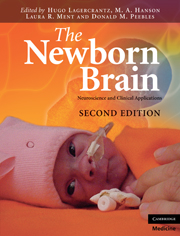Book contents
- Frontmatter
- Contents
- List of contributors
- Preface to the First Edition
- Preface to the Second Edition
- 1 Reflections on the origins of the human brain
- Section 1 Making of the brain
- 2 The molecular basis of central nervous system development
- 3 Holoprosencephaly and microcephaly vera: perturbations of proliferation
- 4 Neuronal migration
- 5 The neonatal synaptic big bang
- 6 Neurotrophic factors in brain development
- 7 Neurotransmitters and neuromodulators
- 8 Glial cell biology
- Section 2 Sensory systems and behavior
- Section 3 Radiological and neurophysiological investigations
- Section 4 Clinical aspects
- Section 5 Follow-up
- Section 6 Consciousness
- Index
- Plate section
- References
7 - Neurotransmitters and neuromodulators
from Section 1 - Making of the brain
Published online by Cambridge University Press: 01 March 2011
- Frontmatter
- Contents
- List of contributors
- Preface to the First Edition
- Preface to the Second Edition
- 1 Reflections on the origins of the human brain
- Section 1 Making of the brain
- 2 The molecular basis of central nervous system development
- 3 Holoprosencephaly and microcephaly vera: perturbations of proliferation
- 4 Neuronal migration
- 5 The neonatal synaptic big bang
- 6 Neurotrophic factors in brain development
- 7 Neurotransmitters and neuromodulators
- 8 Glial cell biology
- Section 2 Sensory systems and behavior
- Section 3 Radiological and neurophysiological investigations
- Section 4 Clinical aspects
- Section 5 Follow-up
- Section 6 Consciousness
- Index
- Plate section
- References
Summary
Introduction
Neuronal communication is mainly mediated by myriads of synapses via neurotransmitters, although there are also electrical synapses. Neurotransmitters can be defined as chemicals released from neurons that act on specific receptors. However, neuromodulators released from other cells, such as adenosine triphosphate (ATP), adenosine, and prostaglandin, can also affect neuronal signaling. Neurotransmitters and their receptor subtypes are expressed in high amounts during certain stages of development, but then persist in only a few synapses (Parnavelas & Cavanagh, 1988).
The transient increase in expression of a transmitter and receptor subtype in the central nervous system (CNS) may occur during a susceptible developmental time window. (A transient increase occurs, but it may not always occur during a critical window.) Development is characterized by timing and spacing or critical periods when some kind of stimulation is essential for correct development. The transmitters and modulators affect formation of synaptic contacts, maturation of synapses, and structural refinement of connectivity by regulating electrical activity, excitability, and release of neurotrophins (Zhang & Poo, 2001). In particular, at birth a cascade of neurotransmitters and transcriptional factors is activated. For example, the norepinephrine surge at birth may be important for initiating the bonding of the infant to the mother by increasing the ability to sense odors (Sullivan et al., 1994). Imprinting at birth and visual input to form the ocular dominance columns also occur during critical periods, and are probably dependent on the switching on and off of neurotransmitters.
- Type
- Chapter
- Information
- The Newborn BrainNeuroscience and Clinical Applications, pp. 99 - 120Publisher: Cambridge University PressPrint publication year: 2010
References
- 4
- Cited by



